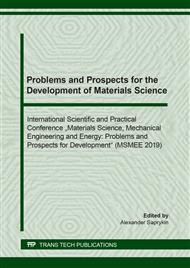[1]
I.V. Suminov, P.N. Belkin, A.D. Epelfeld, B. Ljudin, V.L. Crete, A.M. Borisov, Plazmenno-elektroliticheskoe modificirovanie poverhnosti metallov i splavov, Moscow: the Technosphere, 2011, p.464.
Google Scholar
[2]
J.F. Ivanov, E.V. Kozlov, Obemnaya i poverhnostnaya zakalka konstrukcionnoi stali-morfologicheskianaliz struktury, Izvestiya vuzov. Phyzika, (2002), №3. pp.5-23.
Google Scholar
[3]
P.N. Belkin, Elektrohimiko-termicheskaya obrabotka metallov i splavov, M: Mir, 2005, p.336.
Google Scholar
[4]
N.A. Sosnin, S.A. Ermakov, P.A. Topolyanskiy, Plazmennye tehnologiy. Svarka, nanesenie pokrytiy, uprochnenie, M: Mashinostoenie, 2008, p.406.
Google Scholar
[5]
M. Skakov, B. Rakhadilov, M. Scheffler, E. Batyrbekov, Microstructure and tribological properties of electrolytic plasma nitrided high-speed steel, Materialpruefung/Materials Testing, 57(4), 2015, pp.360-364.
DOI: 10.3139/120.110709
Google Scholar
[6]
M. Skakov, B. Rakhadilov, E. Batyrbekov, M. Scheffler, Change of structure and mechanical properties of R6M5 steel surface layer at electrolytic-plasma nitriding, Advanced Materials Research, 1040, 2014, pp.753-758.
DOI: 10.4028/www.scientific.net/amr.1040.753
Google Scholar
[7]
Skakov M., Rakhadilov B., Sheffler M. Influence of electrolyte plasma treatment on structure, phase composition and microhardness of steel P6M5 // Key Engineering Materials, 2013, - 531-532, pp.627-631.
DOI: 10.4028/www.scientific.net/kem.531-532.627
Google Scholar
[8]
Skakov, M., Rakhadilov, B., Karipbayeva, G. Specifics of microstructure and phase composition of high-speed steel R6M5 // Applied Mechanics and Materials, 2013, - 404, рр. 20-24.
DOI: 10.4028/www.scientific.net/amm.404.20
Google Scholar
[9]
M.K. Skakov, M. Sheffler, Way of Hardening Surface Coating of Details from Steel 30CrMnSi in Electrolytic Plasma. Key engineering materials. – 2013. – Vol. 531-532. – pp.178-181.
DOI: 10.4028/www.scientific.net/kem.531-532.178
Google Scholar
[10]
Skakov M., Batyrbekov E., Zhurerova L., Scheffler M. Microstructure and Microhardness Change of 30CrMnSiA steel Modified Surface Layers by Electrolyte Plasma Processing / Applied Mechanics and Materials, V. 423-426, 2013.- pp.824-827.
DOI: 10.4028/www.scientific.net/amm.423-426.824
Google Scholar
[11]
Mashkov Yu.K. Tribophysics of metals and polymers: monograph / Yu.K. Mashkov. - Omsk: Omsk State Technical University Publishing House, 2013. – P. 240.
Google Scholar
[12]
Shadrin S.Yu., Belkin P.N. // Electron. processing materials. 2002. № 3. - pp.24-30.
Google Scholar


